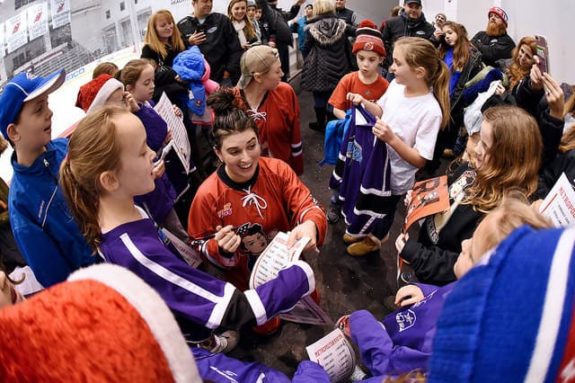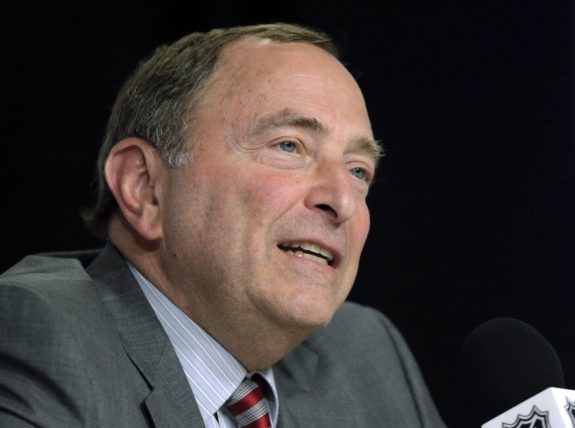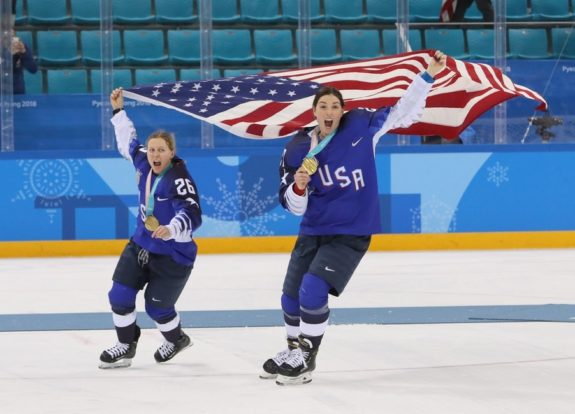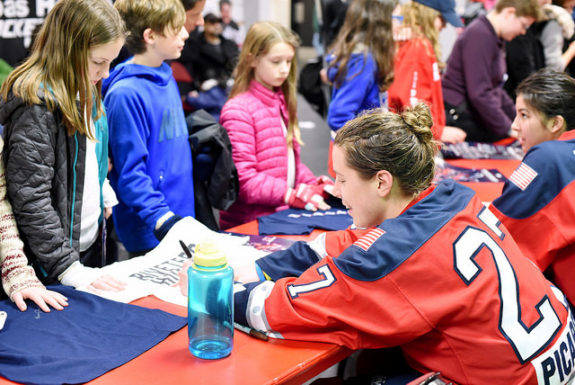Dr. Dorothy Height, a revolutionary leader in the Civil Rights Movement once stated:
“Without service, we would not have a strong quality of life. It’s important to the person who serves as well as the recipient. It’s the way in which we ourselves grow and develop.”
To what extent do those in the hockey community ask themselves this question: “What am I doing to help others?”

The answer is very personal and unique to the individual. Only you know in your heart how much you are doing to be of service, and what the motivations behind your actions may be.
There has been a lot transpiring in women’s hockey since Spring 2019, and it would be fair to say that it has been quite stressful.
One longtime women’s professional league has folded, legal battles are happening between a surviving league and a former owner, and there is a division between players that has seemingly permeated throughout all levels of proponency in women’s hockey.
The Constraints of Taking a “Side”
Some think that the lines have clearly been drawn, and that it is a black and white issue. Rubbish. It is not as simple as “taking a side,” and it is a ridiculous constraint to put on such a complex situation. There are good people with good hearts on both sides of the equation, and with admirable intentions.
But whether you are an NWHL player, a PWHPA player, an NCAA player, or a player with no affiliation at all, ask yourself this: “Are you doing your best to follow the Declaration of Principles, and do you believe in them?”
Heck, do players even remember what they are?
They should. After all, the American Collegiate Hockey Association (ACHA), Canadian Women’s Hockey League (CWHL), Hockey Canada, the International Ice Hockey Federation (IIHF), National Collegiate Athletic Association (NCAA), National Women’s Hockey League (NWHL), and USA Hockey all did at one point. Each of those entities signed their acknowledgement and belief in the Principles.
Everyone certainly seemed to be on board at the time.
Those same affiliations pretty much cover every avenue of the women’s hockey spectrum for North America and then some. Speaking specifically to the players, no matter which “side” you are on, likely 99% of you were at one point involved in an organization that believed in the Principles. When you chose your “side,” did you do so believing that it was best for hockey, or did you have a different motivation?
A lot of questions are being thrown around here, we know. But how does anyone get to to an understanding of anything without asking questions, especially philosophical ones?
An Explanation of the Principles
Maybe everyone needs a refresher of sorts.
On Sept. 6, 2017, the National Hockey League (NHL) and the National Hockey League Players’ Association (NHLPA) unveiled hockey’s Declaration of Principles.
The purpose of which has been to advance policies, programs and initiatives, while inspiring fans, players and communities to create the best possible experience for the entire hockey community. This came with the understanding that hockey is a wonderful channel for building character, fostering positive values and developing key life skills that transcend the game.
The Declaration of Principles in and of itself is comprised from a set of commonly shared beliefs that articulate a vision of delivering the best possible hockey experience for participants and their families. The Principles themselves are meant to serve as an internal compass to help guide decisions and shift behaviors of hockey organizations, as well as players, parents, coaches, fans, partners and all those who represent and care for the sport of hockey.

Much of the initiative was spearheaded by Hockey Hall of Famer Pat LaFontaine, as the NHL’s vice president for hockey development. LaFontaine is one of the classiest, most selfless individuals a person could ever hope to meet, and he is the ideal candidate for handling any moral issues within the game.
Even NHL Commissioner Gary Bettman – the one who many speculate could be a savior of sorts for professional women’s hockey – stated this at the time when the Principles were unveiled:
“The Declaration of Principles represents the hockey world speaking with one voice: our game teaches life lessons that can guide a meaningful future. While not everyone who plays the game will have an NHL career, every player at every level — and the family and friends of every player — can enjoy rewarding experiences and share a common commitment to respect, inclusiveness and sportsmanship.”
The Principles Themselves
Here are the Principles themselves if you do not know them already:
- Hockey should be an enjoyable family experience; all stakeholders — organizations, players, parents, siblings, coaches, referees, volunteers and rink operators — play a role in this effort.
- Hockey’s greatest value is the role it plays in the development of character and life skills.
- All hockey organizations — regardless of size or level of competition — bring value to players and families in their ability to deliver a positive family experience.
- Physical activity is important for a healthy body, mind and spirit.
- There are significant benefits of youth participation in multiple sports.
- Hockey programs should be age-appropriate for all players, accounting for each individual’s physical, emotional and cognitive development.
- There is great value in all forms of hockey, both on and off the ice.
- All hockey programs should provide a safe, positive and inclusive environment for players and families regardless of race, color, religion, national origin, gender, age, disability, sexual orientation and socio-economic status. Simply put, hockey is for everyone.
It is a heartfelt list of beliefs, and very much to the point. As the corresponding hashtag for the Principles goes, #ThisIsHockey. The Principles are what hockey should be about.
But has women’s hockey been losing sight of that? It feels that it has sometimes, recently. Especially in the early goings of this divide between the players, a lot of shade was thrown back and forth on social media and it is fair to say that some bullying was in effect too.
The First Principle in Depth
Relating the Principles to the current state of the women’s game is critically important. We would like to go through a few of the Principles in detail, and discuss what bearing they have.
We will begin with the first one: Hockey should be an enjoyable family experience; all stakeholders — organizations, players, parents, siblings, coaches, referees, volunteers and rink operators — play a role in this effort.
At the heart of what is dividing the NWHL/NWHLPA and the PWPHA are the players and the differences between their common beliefs. To use that same simple constraint, it is one “side” versus another – a “with us, or against us” mentality.
Both “sides” have acknowledged their belief in a better tomorrow for the young girls who will someday fill the skates of the professionals. They each have their own hashtags too: #GrowTheGame versus #ForTheGame.
But has either “side” given any consideration to the other stakeholders who are embedded within the women’s game, and do the “sides” even care?

Perhaps it has happened, but we are not aware of any broadcasters, writers, photographers, ushers, ticket takers, Zamboni drivers, volunteers, merchandisers, concession stand workers, athletic trainers, public address announcers, equipment managers, statisticians, time keepers, or anyone at those levels being asked for an opinion or to have a say in the matter.
These people were either considered or they weren’t.
While many of the aforementioned have publicly taken a side, no one has outwardly been given an opportunity to have some impactful input. Rather, these individuals just mentioned must simply hope for the best, and deal with whatever the outcome ends up being. Some would say that is unfair, and many of these same people had to live it once when the CWHL folded. Heaven help them if they have to go through it again.
As a matter of common courtesy, it might serve any current or future league well to get the thoughts of these other important stakeholders, instead of having them lying in the wait and potentially being casualties of this divide.
That is not even making mention of the fans. While the fans have already shown immense support to both “sides”, they have been placed in a precarious situation as well, while being given little to no insight into the behind-the-scenes workings. Frankly, a fan is not as privy to hockey’s operations as some of the other stakeholders that we mentioned.
But whether we are talking women’s hockey, the NHL, NBA or WNBA basketball, Major League Baseball, or whatever, it is imperative that everyone acknowledges that there would no professional sports without fans. It is wrongful to patronize them by playing with semantics or giving false hope either way.
The Second Principle in Depth
This one and its bearing on women’s hockey may be the hardest to weigh, but not at face value.
Hockey’s greatest value is the role it plays in the development of character and life skills.
There is no question that hockey develops character and life skills. It is the greatest sport in the world, and it naturally enriches lives for those who become part of it. Teamwork, being coachable, suffering loss, striving for victory and success, being humble and knowing your role within an organization – all of those practices can stem from hockey and in abundance.
But when a player’s hockey career closes, in what ways will she apply those skills to everyday life? The desire will certainly be there, but the opportunity may not be.
For example – and it is actually rather upsetting that this is the case – no women’s hockey players will be receiving millions of dollars in salary anytime soon. Pensions or retirement funds, should they come into play within the next few seasons, will be minimal at best. Certainly not enough to live the rest of one’s life upon.
Meanwhile, should a new league come to fruition, the thought will be that the players will be receiving a livable wage. Well, what happens after they retire from the game? If the focus is solely hockey, chances are that they will not be earning other job experience during the years that they play.
When a player retires, say at 35 years of age, where will her income begotten next, and what will her occupation be until she is in her 60s? It would stand to reason that not all 200 players in support of #ForTheGame will become hockey coaches or find another hockey-related job.
Frankly, not all players have the same financial situations and it is a real concern for some of them as to how they will earn a living after they have retired from hockey. Career opportunities while playing hockey could essentially slip away in the meantime.
It is definitely a tricky slope to navigate, and players need to be concerned over the idea of securing a proper stage to use their hockey-learned life skills once their playing days are over. Planning for the future is something each player needs to be mindful of.
The Third Principle in Depth
Onto the third Principle:
All hockey organizations — regardless of size or level of competition — bring value to players and families in their ability to deliver a positive family experience.
Let us not undermine each other here. If we all are really proponents of women’s hockey, then let us agree that we can all bring something good and dear to the table.
Word on the street is that the PWHPA is organizing games to be played between its members in a number of cities across North America. That is fantastic. Be involved in your communities, be tangible to children, inspire them to follow in your footsteps. #ForTheGame players such as Noora Räty, Amanda Kessel, Marie-Philip Poulin and others have already been doing a tremendous job with summer hockey camps for youngsters in 2019, and had done so in the years preceding. They are simply awesome.
The same holds true for the NWHL.
There has been some scoffing over the thought that national team players will not be participating in the league for the 2019-20 season, and that the NWHL will supplement their teams with collegiate players. Absolutely. Big deal. So what? There is no Canadian junior hockey or USA junior hockey system to act as a natural farm system to the NWHL. The NCAA is the “farm system” in most instances.
It is rather presumptuous to think that the upcoming Season Five of the league will not be entertaining, and that new faces will not rise to the occasion. Each season of the NWHL has brought new fan favorites to the forefront. It will be the same for 2019-20, and a number of familiar favs have already inked new contracts.
The fact of the matter is that both – and any other women’s organization, for that matter – can bring value to the players and families. What parents or grandparents do not love seeing their daughter or granddaughter out on the ice in her natural element? The current divide is likely just as tedious for the players’ families as it is for the players themselves.
When it comes down to it, hockey is hockey and people just want to see the players give it their all. Fans can cheer for a national team player with just as much heart and spirit as a Division-III athlete playing her first professional game.
The Eighth Principle in Depth
We will look at one final Principle from the list. The eighth one, as it may be the most important:
All hockey programs should provide a safe, positive and inclusive environment for players and families regardless of race, color, religion, national origin, gender, age, disability, sexual orientation and socio-economic status. Simply put, hockey is for everyone.
This one has the potential to cause further consternation, but it does not mean that we should refrain from discussing it.
It would not be going out on a limb to think that not every player feels welcome in the NWHL, and that not every player feels welcome in the PWHPA. This could be for any number of reasons, and some are likely listed within the Eighth Principle itself. Safety, positivity and socio-economic status particularly come to mind.

In fact, there is every reason to think that a number of players must be feeling very torn and stressed over having to choose one option or the other.
Some players may very much be in need of a salary of $5,000, give or take, this season and may not be in a position to turn it down. What happened to the adage of “If you can play, you can play”? That also means that if a player wants to play hockey for whatever reason she has, let her play hockey – for crying out loud – and keep your thoughts to yourself. It is just that simple. And if a player does not want to play, she does not have to – no questions asked.
We can only request that for all players and anyone else whose lives women’s hockey touches, please live and let live. Every player has the right to decide what is best for herself, and she should feel no need to explain her decision. A player is also allowed to change her mind too.
Be of Service to Others
This was a lot and it was lengthy. Do with it what you will, as it is certain to not appeal to everyone. That is okay too – supposedly, hockey writers are allowed to have their own opinions as well.
On a personal note, I have people whom I care for on both “sides” of this equation, and I want to be respectful of everyone’s standpoint while hopefully also giving them more ideas to ponder. The solutions to all of the concerns in women’s hockey right now are indeed attainable – it may just take some time to figure out.
But if there is one takeaway that can be had from reexamining the Declaration of Principles, it should be this:
No matter what your stance on professional women’s hockey in North America may be, did you take that stance thinking primarily of yourself in mind, or did you truly do so for the betterment and service of others?
Oh, and #ThisIsHockey…